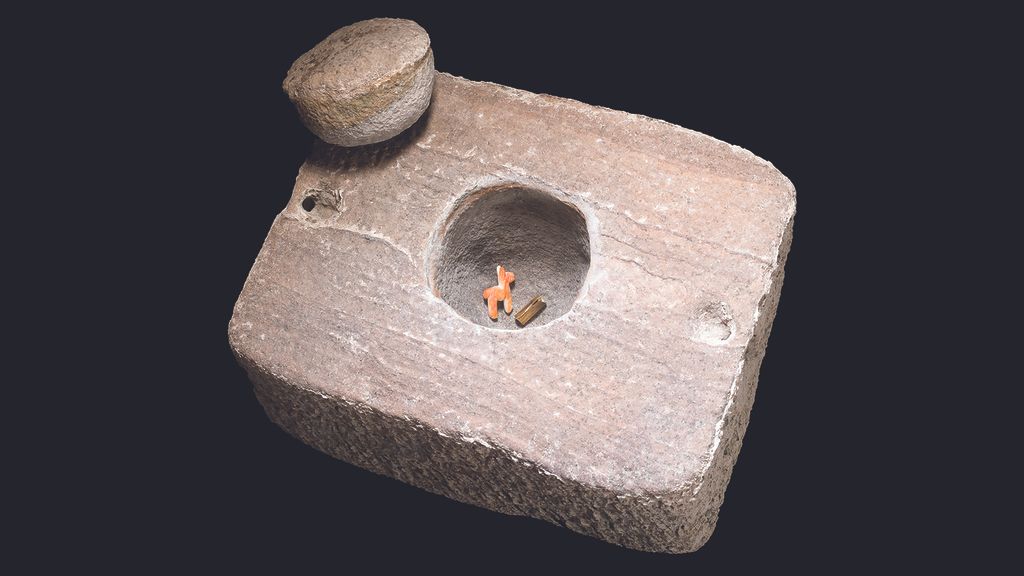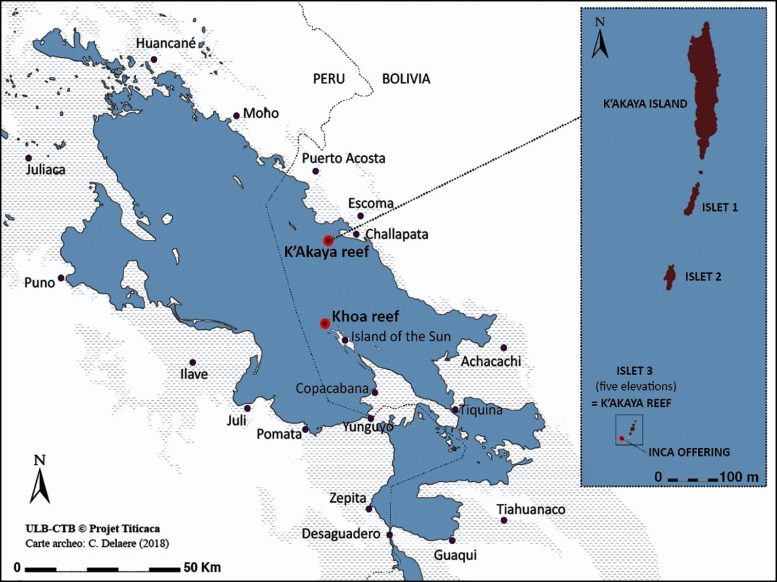Anthropology
Related: About this forum1st intact evidence of Incas' underwater ritual offerings found in a lake in the Andes
By Mindy Weisberger - Senior Writer a day ago
A small stone box contained a bracelet and a carved llama, and may have once held human blood.

(Image: © Teddy Seguin, Université libre de Bruxelles/Antiquity Publications Ltd.)
For the first time, archaeologists have described an intact underwater offering made by the Inca people, deposited into Lake Titicaca in the Andes about 500 years ago.
The discovery hints that evidence of other important Incan rituals, such as human sacrifices, may also lurk underwater.
The Spanish recorded the Incan practice of placing offerings in water in the 16th century, and this offering — a stone box — is the first such object to be discovered in one piece. It holds a small gold bracelet and a shell carved to resemble an alpaca or llama. The box may have also contained human blood, according to a new study.
Lake Titicaca extends into what is now Bolivia and Peru; it is one of South America's largest lakes, and is known for its importance to the Incas. Incan origin myths name the lake as the birthplace of the sun, and a ceremonial complex of Incan shrines and temples once stood on the lake's Isla del Sol, or Island of the Sun.
In 1977, amateur divers from Japan found several stone boxes underwater on the Khoa reef near the island's temple complex. Their age and location suggested that the objects had been placed in the lake by the Incas for ritual purposes. More boxes were recovered from the reef during dives in 1988 and 1992, but nearly all of the boxes were broken or had been looted.
More:
https://www.livescience.com/incas-underwater-offering.html
Judi Lynn
(162,390 posts)TOPICS:ArchaeologyPenn State University
By PENN STATE UNIVERSITY AUGUST 3, 2020
. . .

Map of Lake Titicaca showing islands. Credit: José Capriles, Penn State and Christophe Delaere, Université libre de Bruxelles
“Since 2012, the Université libre de Bruxelles has implemented a research program with the goal of locating and inventorying the underwater heritage of Lake Titicaca,” said Delaere. “Our team has systematically surveyed around the islands and reefs in the Bolivian side of Lake Titicaca.”
The K’akaya Archipelago is west of Challapata Bay in the eastern shore of Lake Titicaca and is a series of a main island and three small ones. K’akaya reef is the last islet of the small chain and is covered in bird droppings.
The divers retrieved the box intact although currents had eroded one side. The box was tightly sealed, but not watertight. Resting in the box, beneath the silt that had filtered in, was the spondylus shell llama and the rolled gold foil.
One indication that these boxes contain artifacts valuable enough for offerings, beside the gold foil, is the spondylus shell llama. The closest location where the Inca could obtain this spiny oyster shell was in warm coastal ocean waters off the coast of Ecuador.
Finding this box in a new location suggests to the researchers that Lake Titicaca was a locus of ritual and ceremonial activity by the Inca. Similar offerings are found in other parts of what was the Inca Empire, some on land and some on water, but the researchers think that the lake was important in the consolidation of the empire.
According to Capriles, as the Inca radiated out from Cuzco in Peru, Lake Titicaca became a focal point. Prior archaeological evidence indicates that many of the islands, reefs and archipelagos contain ruins of temples and other monumental architecture.
More:
https://scitechdaily.com/surprise-finding-of-ancient-offering-at-the-bottom-of-lake-titicaca/
Judi Lynn
(162,390 posts)Hints of mysterious religion discovered in world’s highest lake
Gold artifacts, precious shells and evidence of animal sacrifice in Lake Titicaca point to a belief system that helped organize the ancient Tiwanaku state, researchers claim.
3 MINUTE READ
BY ERIN BLAKEMORE
PUBLISHED APRIL 1, 2019
About 1,200 years ago, a reef in the middle of Lake Titicaca in what is now Bolivia became the repository of a people’s most valued possessions. In 2013, a sparkling cache of those objects was unearthed by underwater archaeologists. Six years later, researchers think they now know what the objects represent—evidence of a religion that helped the Tiwanaku state become a dominant force in the region.
Results of the excavation were revealed in a paper published today in the journal Proceedings of the National Academy of Sciences. Gold objects, metal ornaments, semiprecious stones, and incense burners recovered at the site suggest the reef—located near the Island of the Sun, home to multiple Tiwanaku sacred sites—was once used as a ritual site for the ancient state.
Anthropologists are still piecing together details of the religion that helped make the Tiwanaku state, which existed between about 500 A.D. and 1,000 A.D. and extended to Chile and Peru at its height, so powerful. The Tiwanaku people didn’t leave behind significant traces of military might, and the state is thought to have amassed influence from religion and trade. And though archaeologists have discovered plenty of archaeological evidence of Tiwanaku religious beliefs, they’re still piecing together the meanings of the religion and how it may have contributed to the state’s expansion.
Artifacts found from the site, known as Khoa reef, include two gold medallions that represent Tiwanaku’s ray-faced deity and metal plaques that portray a mythical puma-llama hybrid. Divers also recovered the remains of real animals, including the bones of at least three young sacrificed llamas.
More:
https://www.nationalgeographic.com/culture/2019/04/evidence-ancient-religion-discovered-lake-titicaca/
Judi Lynn
(162,390 posts)Alex Bellos, South America correspondent
@alexbellos
Published onWed 23 Aug 2000 20.38 EDT
An international team of scientists announced the finding this week after making more than 200 dives in Titicaca, which, at 3,800m above sea level, is the world's highest navigable lake.
"We've found what appears to have been a 200-metre-long, 50-metre-wide holy temple, a terrace for crops, a pre-Incan road and an 800-metre-long containing wall," said Lorenzo Epis, the Italian leading the Atahuallpa 2000 expedition. Ceramic artefacts were also found on the lake's floor.
Titicaca has long been the subject of legends about a lost underwater city, but there has been little research because of the logistical difficulties of diving at altitude.
While a submerged city has not been found, Mr Epis said the ruins appeared to be 1,000 to 1,500 years old. It thus predates the Incas and could point to the Tihuanaco people, who lived on Titicaca's shores before becoming part of the Incan empire.
"This means our civilisations have left more footprints than we had thought," said Antonio Eguino, Bolivia's vice-minister of culture. The ruins were found in an area of the lake between the town of Copacabana and the popular tourist destinations of the Island of the Sun and Island of the Moon. The divers followed a submerged road until they arrived at the discoveries, at a depth of about 20 metres.
More:
https://www.theguardian.com/world/2000/aug/24/bolivia
Judi Lynn
(162,390 posts)By ABC News
January 7, 2006, 6:22 AM
2 min read
L A P A Z, Bolivia, Aug. 24, 2000 -- A stone anchor and animal bones were among the artifacts scientists Wednesday said they had found beneath South America’s Lake Titicaca in what is thought to be a giant 1000-year-old temple.
After 18 days of diving below the clear waters of Titicaca, scientists said Tuesday they had discovered a 660-foot long, 160-foot wide temple, a terrace for crops, a pre-Incan road and an 2,600-foot containing wall.
“I strongly support the hypothesis that was was found by the ‘Atahuallpa 2000’ expedition are the ruins of a submerged pre-Columbian temple,” said Eduardo Pareja, a Bolivian scientist who was among those who explored the site, around 90 miles northeast of the Bolivian capital La Paz.
Filmed During 200 Dives
Pareja, who termed the discovery the greatest archeological find of the new millennium, showed Reuters the artifacts in his small office at Bolivia’s National Archeology Department. He said the animal bones—of cameloid animals such as llamas — might have been from sacrifices.
More:
https://abcnews.go.com/Technology/story?id=120004&page=1